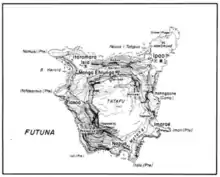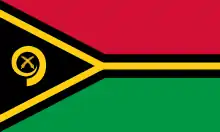Futuna Island, Vanuatu
Futuna is an island in the Tafea province of Vanuatu. It is the easternmost island in the country.[1]
| Geography | |
|---|---|
| Location | South Pacific Ocean |
| Coordinates | 19°32′S 170°13′E |
| Archipelago | Vanuatu |
| Area | 11 km2 (4.2 sq mi) |
| Highest elevation | 666 m (2185 ft) |
| Highest point | Tatafou |
| Administration | |
| Province | Tafea Province |
| Largest settlement | Imounga |
| Demographics | |
| Population | 613 (2016) |
| Ethnic groups | Melanesians |
Geography

It was formed by the uplift of an underwater volcano, which last erupted in the Pleistocene, at least 11,000 years ago. It reaches a height of 666 m. It is sometimes called West Futuna to distinguish it from Futuna Island, Wallis and Futuna, and also can be known Erronan by its island neighbour, Tanna. Although it is part of the Melanesian country of Vanuatu it is considered to be a Polynesian outlier.
History
Futuna is sometimes said to be the 'Gateway' to the gospel in Vanuatu, the first island where its inhabitants accepted the gospel of Jesus Christ. During the late 1800s several missionaries lived on this island for the purpose of preaching the gospel to the natives, and in coordination with missionaries living on other neighbouring islands tried to introduce western living and influence for improvement of the well being of its people. Notable missionaries that have lived on this island are Rev. Joseph Copeland, and medical doctor John William Gunn.
Rev. Joseph Copeland had lived on the island for 10 years, from 1866, before he moved on to Tanna. Dr. William Gunn had lived on the island from 1883-1917. He is more well known to the local Futunese, as he had made a bigger impact to the establishments of churches around the island, and had brought many to be converted and baptised. He has also made significant contributions to the translation of bible and hymns[2] from English to the Futunese language, and documented many Futunese customs and cultural practices in his book "The Gospel in Futuna[3]".
Population
The island has a population of 535 according to the 2009 census.[4] There are currently 5 main villages on Futuna Island:
- Iasoa
- Ipao
- Matangi (Consists of Iraro, Marae, Itavai and Iakana)
- Ihsia
- Imounga
The main village is Imounga, in the northwest. Ipao, in the northeast, is just west of the airport. The island has ten regions: Iraro, Itapapa, Itapasiesi, Matangi, Matowei, Nabao, Nariari, Rakaoroa, Serinao, and Tchinaroa.
The island also have several Futunese diaspora communities living in other islands such as main island Efate, Tanna, Aneityum and Espiritu Santo.
Transportation
The island is served by its only domestic airport, Futuna Airport, which requires passengers to transit from Tanna. The airport operates on 2 flights a week. The island also has a small shipping dock at Herald Bay, where cargo ships and ferry travel every couple of months.
The irregularity of the shipping boat visits has been an inconvenience to the communities needing to ship various goods between the Tafea islands. The current frequency of ship travels has decreased compared to past ship travels during missionary years (1800-1900), where it is known for ships to travel to Futuna twice a month. During the missionary years, missionaries living on other Tafea islands were the cause for much of the shipping traffic, with goods, letters, persons exchanged/transported between islands frequently.
Education
The island has a school located in the village of Ihsia. Previously known as Ihsia Secondary School, the school changed its name in 2015 to Edward Nipake Natapei Memorial School[5] in honor of famous politician, Edward Nipake Natapei.
The school offers education from Year 1 to Year 7 as part of its primary school education; and Year 8 to Year 10 as part of its secondary.
Music and Dance
Music
The inhabitants of the island have a style of hymn singing, established by 19th century missionaries, which is distinctive among Pacific islands.[6] Futuna has a rich history in 'kastom songs', traditional songs that have been passed down from generation to generation.
These songs may contain stories of real persons, events or myths. Some of the 'kastom songs' share historical events such as 'Tahfe Tiatea itoga(The Queensland song).[7] This song tells the story several Futunese who were recruited as farm labourers during the 'blackbirding' period, in particular, several were recruited to work in Bundaberg, Maryborough and Mackay.
During that same period, more'kastom songs' were created based on the labourers who also visited neighbouring Fiji[8]
There are also several Gospel Music group that have made successful releases into the Pacific music industry. Some of the notable music groups and solo artists are:
- Albea Nalisa
- Fatuana Mahtua
- Fatumanu
- Transformation Singers[9]
Dance
Futuna is quite well-known in Vanuatu for its strong custom dance practices and creative Christian worship dance groups. It is common in Futuna to participate in dance groups to perform in any occasion whether it be weddings, religious events or commemorate national holidays.
Some of these custom dance practices have become commercialized to become a means of income for some Futunese communities, with the rise of Cultural groups such as Ekasup Cultural Group and Pepeio cultural Group, performing to tourism and hospitality events.
These groups often perform custom ceremonies and performances, in traditional costumes to educate tour groups about Futunese cultural food, stories, songs and other ways of living.[10]
Notable people
See also
- Polynesian outliers
References
- UNEP Islands Directory
- "Search results for 'william gunn futuna' - Books". Trove. Retrieved 2016-03-25.
- Gunn, William. The gospel in Futuna; with chapters on the islands of the new Hebrides, the people, their customs, religious beliefs, etc. London [etc.] : Hodder and Stoughton.
- 2009 Census Summary release final Archived December 21, 2013, at the Wayback Machine - Government of Vanuatu
- "Vanuatu Daily Post: Ishia changes to Natapei school". Vanuatu Daily Post. 2 August 2015.
- UNESCO - Culture
- https://open.spotify.com/track/6UjSpt28jrJN3BgUxkIQzp?si=SsQFTehFRme4Z9swMxhWJQ. Missing or empty
|title=(help) - Thomas, Allan (1992). "Songs as History: A Preliminary Assessment of Two Songs of the Recruiting Era Recently Recorded in West Futuna, Vanuatu". The Journal of Pacific History. 27 (2): 229–236. doi:10.1080/00223349208572709. JSTOR 25169130.
- "Transformation Singers: Sirananoa Vau".
- "Vanuatu Activities-Ekasup Cultural Village" – via YouTube.
